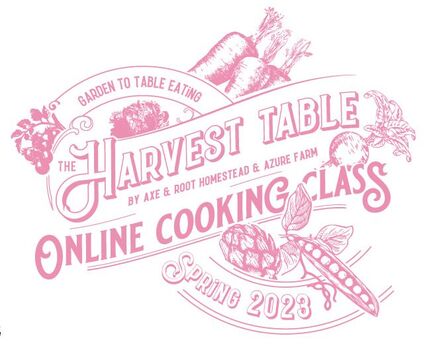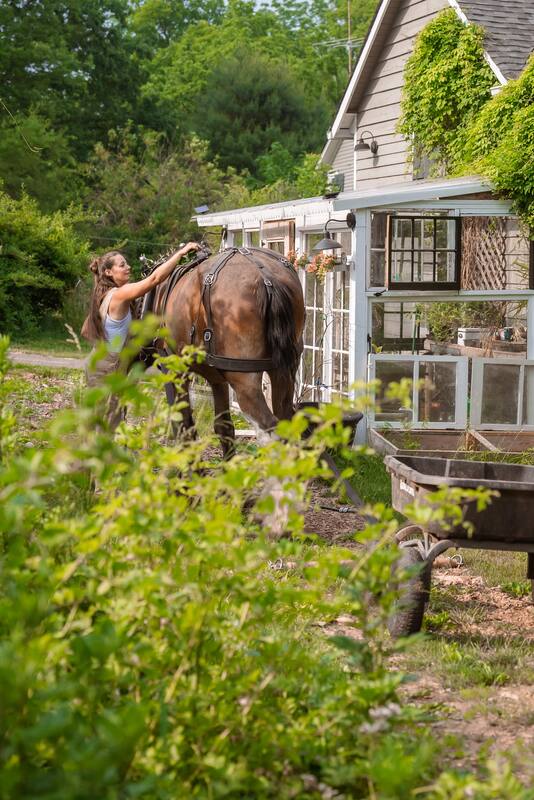|
What is the point of raising animals if you don’t eat them? Lots of reasons. Consider function, helping endangered species—and remember how stock density plays into all of that.
So many people ask me, “Why do you have animals if you’re plant-based?” The short answer is that animals offer way more function to the homestead than just meat. The long answer is that every animal contributes to our permaculture ecosystem here. The horses provide pulling power, trail riding, manure for compost, and they are dead-end hosts for our sheep parasites. The sheep are dead-end hosts for horse parasites, keep the equines healthy. They also are a good fit for our natural grassy forage. Wool is just a plus. The grazing activity of both the sheep and horses maintain forageable cover crop growth and height, which is what encourages carbon absorption. Their droppings also return nutrients to our soils. Ducks are great for our wetlands and for snail, slug, and pillbug control. Their eggs are sold at our farm stand and livestock conservancy duckling breeds are sold to help threatened populations. The geese eat the weeds left behind by the horses and sheep, graze lawns, lay eggs, and act as alarm bells for our duck flock. Guinea fowl graze our yards, woods, and pastures drastically decreasing our tick population. Our barn cats and invited native owls work to keep rodent populations in check.
I’ve seen A-frame and water levels for marking swales. They’re clunky, often require two people, and the A-frame string is prone to wind movement. Then I found this idea from @WestTexasGardenExperiment I whipped one up in 5 minutes and in another 20, had my new swales marked.
I’m digging a swale not just as a permaculture to-do list item—it’s actually going to help slow, catch, and spread water in my sacrifice plot. It will be staked with flags and bamboo poles post construction to protect my livestock and keep them away from the trench. In my previous YouTube video, I created a level and marked my swales on contour. Today I finally just went for it and dug out the swale ditch, piling the dirt on the downhill side as a berm. In the video I said I dug to a depth of 6-8” since livestock graze the area. I actually ended up doing about 10” deep and plan to keep the stakes and poles in the ground for now, for the safety of the animals. After 24 hours the swale filled and the downhill side was drying up! After the first rainfall the water was successfully collected, spread and waiting for slow absorption.
We’re back! Join Angela @axeandroothomestead & Annette @azurefarm for their second LIVE cooking class! They will cook in real time and show you how to make delicious spring-based garden-to-table recipes.
What: For this spring class we will teach you how to make homemade pasta, a delicious tart, and more! When and Where: The class will be on Sunday March 26, 2023 from 2-4 pm via ZOOM. How: Sign up here. You will receive: 👩🏻🍳A box of goodies for the class (We created some beautiful and useful items specifically for this class). 🧑🍳Pantry Items + a gift card from Country Life Foods 👨🍳A booklet with all new recipes for spring. The booklet also includes homestead checklists for spring, guides on how to harvest and store your spring produce, and more. This will be an interactive class where you cook some of the dishes alongside us! There are LIMITED SPOTS so sign up before the class fills up. This class is for residents of the US only (but should you really want to attend send us a DM and we will do our best to accommodate). You can find The Harvest Table Cookbook on Amazon.com I stopped using traditional hoses in cold weather about three years ago. Flexible, expandable hoses can be stored in a bucket and brought indoors between uses. The catch? Make sure to fully drain it before storing. Watch the video for details. There’s still plenty of cold days ahead of us so if you’re getting fed up with freezing hose lines, make the switch! By the end of winter, the hay barn floor is loaded with fallen hay scraps. After the dogs and cats have been sleeping on it, and foot traffic has been walking on it, I prefer not to give it to my animals. Instead, I make this scrap hay work for me by hauling it out to pasture. Hay is loaded with seed and a great way to reseed areas. As it breaks down the seeds fall to the soil’s surface while the green foliage remains as a mulch. There’s no such thing as hay waste!
After a severe hoof rot infection, my vet helped me to eliminate the bacteria and heal my sheep in just over two weeks. We use trimming, Koppertox, SugarDine, cotton pads, vet wrap and duct tape. This dressing is changed every three days, more if the sheep can not be kept in a dry area. Inflammation was reduced and the wound puss was completely gone fast!
This post is not a replacement for professional veterinary care. It is meant for educational purposes only. Have your vet monitor the infection to ensure the sheep is healing. Discontinue use if irritation occurs. It's garden planning season! How do you know how much food to grow for canning? Well, there’s no straight answer because there’s too many variables. While canning recipes are consistent, plant yield is based on crop variety, season length, weather, soil type and quality and soil inputs. We also need to account for family consumption rate, ages, number of family members, etc.
But what we *can* do (no pun intended) to determine how much to grow is start by evaluating what you make for meals in an average week: 1. How often do you buy specific canned goods/ingredients? 2. From there, determine how many canned goods of a certain type you need. 3. Next we look at how many pieces of produce (on average) go into your desired can size. 4. Research crop variety average yields. 5. If we know how much food we need, we can better determine how many plants we need. Here’s my calculations for what my family of four eats based on the following common items. Yours will look different and this is just an example. TOMATO SAUCE Stats: 13 pounds are needed per canner load of 9 pints / 3 Tomatoes per pound /39 tomatoes in 9 pints / 4.3 tomatoes per pint / 1 plant can yield 20 tomatoes (average) / 104 pints needed 448 tomatoes needed 23 plants for preservation + fresh eating + donation = 35 PLANTS ...... BLACK BEANS Stats: 175g (6oz) black beans in pint / 1 pint per week / 52 pints per year 175x52 = 9100g per year Plant yield highly variable, can’t estimate weight so go by average plants per person 20 plants per person for a year 20x4 = 80 PLANTS ...... APPLESAUCE Stats: 28 medium apples = 9 pints / 10 pints for the year / 280 apples 125 apples per bushel, on average I need 2 bushels for canning + fresh eating + donation Single semi dwarf apple tree produces up to 500 apples in a season = 1 SEMI-DWARF APPLE TREE ...... DILL PICKLES Stats: 3-4 average sized cucumbers to fill pint jar / 25 pints needed for year / 12 cucumbers per plant, average 4x25 = 100 cucumbers needed 100/12 = 9 plants for canning + fresh eating + donation = 16 PLANTS
The speed with which the fox notices a change in our routine is astounding. And so it was, last night, when I woke up at 1:30am to the sound of the vixen's call outside my bedroom window. With two guardian dogs that roam the property by night, keeping predators away from our flock of sheep and birds, it's unusual to hear our neighboring fox so close. I know exactly where she lives just over the property line by our lower field, and I've seen her kits each year from the age of young pups grow to independent hunters. Her presence isn't new, and isn't even entirely unwelcome so long as she leaves my critters alone. That's what the livestock guardian dogs are for.
When we take a vacation, the fox immediately recognizes the absence of the free-ranging dogs. Aaxlu is enclosed with his flock of ducks, geese, and guinea fowl to make sure he stays contained while we're away... and to ensure the birds are under his protection while I'm gone. Orsa takes charge of her sheep and sounds her loud bark at coyote from either the lower field or the in-out run that is attached to the sheep barn. And this is exactly the setting in which the fox found the dogs last night, for a sudden cold snap blasted the farm. This meant frozen water troughs and buckets brought on by the cold wind. I could better ensure fresh water for the dogs if they stayed enclosed with their stock; more body heat, more water disturbance, less buckets for me to crack, and stock tank heaters. The screech was loud and just to the front of the barn which resides across the drive from my window. After every scream and chatter she sounded, the dogs began barking incessantly; frustrated at their lack of ability to chase after her. I got up and peered through my windows and, thankfully, the moon was full, casting a gentle spotlight over the pastures and yards. I could not see her but I knew exactly where she was in the shadows. Eventually the chorus of canines settled and I went back to sleep, hoping she hadn't made her way into the barn. She knows exactly where the dog and cat food is kept in large bins, and isn't deterred by metal flashing or locks. Not once did I fear for the safety of my animals. This morning when stepping outside for breakfast rounds, the dogs were visibly agitated. I let them out of their respective fences and immediately they chased for the fox, in the direction of her den. Orsa's nose stayed to the ground following the scent, while Aaxlu charged ahead. Perhaps they remembered the cacophony from the night before, or maybe she had just passed through. But as I watched them follow the fox trail I was, yet again, reminded of the gratitude I have for the commitment and protection these two dogs provide. I could not do what I do here without them. And now that the cold snap has moved on, the dogs will resume their usual positions in tonight's occupation. |
Angela is the farmer and content creator behind Axe & Root Homestead® LLC. This historic six-acre permaculture farm is home to two Clydesdale horses, ten honeybee hives, five sheep, two guardian dogs, barn cats and a flock of 40 geese and ducks. The farm produces maple syrup, fruit from a small orchard and loads of garden produce for consumption, preservation and donation to the local food pantry.
The Sustainable Homestead is available NOW!
Categories
All
|


